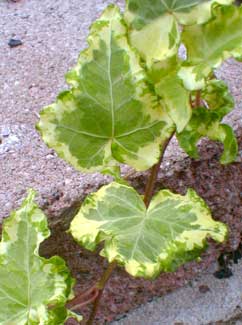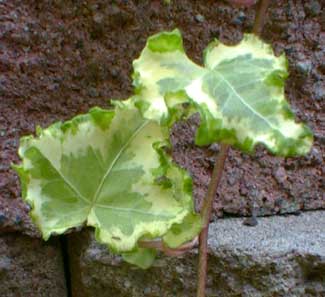
'Golden Curl'
Variegated Ivy
"A graceful ivy fair & young
Around a dear old ruin twined
And closer still it crept & clung
When o'er swept an angry wind."
-M.T.H.,
Edinburgh,
August 1850
Edinburgh,
August 1850
This ivy is in at least two classes, the "curlies" & the "variegateds." Highly decorative leaves have undulate, lacy, or crinkled edges, cream-colored to chartreuse variegation, & semi-dwarf habit (not a miniature). It is not compact but spreads its leaves out along creeping vines; I would hazard expert pinching could make it more compact, though I've not tried it to find out.
So many ivies are offered through the nursery trade without identification. This unusual ivy came from a local grower, Foxglove Greenhouses, which had been wholesaling it under the name 'Chartreuse & Green' in half-quotes as though that were a cultivar name, though they did not know what variety it might be so just described its color.
It was identified for me by Russell A. Windle, Director of Research, of the American Ivy Society. He tells me the variety has been marketed by a Danish grower as 'Golden Caecilia' to contrast it with an established white-variegated curly called 'Caecilia' (formerly 'Clotted Cream'). But 'Golden Caecilia' is not an official registered name no more than is 'Chartreuse & Green.' I also contacted Angela Tandy of Fibrex Nurseries, Ltd., "the home of the National Hedera Collection" in England, to see if she recognized it. She informed me, "This is a variety of ivy we grow. Being unnamed & as I have been unable to find a name, I have called it 'Richard John' after my late father until someone can tell me otherwise."
 Having found three unofficial names, I was about willing to accept that it was a totally unnamed variety slowly making its way around the world with several ad hoc names attached. But Russell Windle was still rooting about in my behalf, & conferring with Ron Whitehouse of Whitehouse Nurseries in England, & was pointed to Peter Q. Rose's Gardener's Guide to Growing Ivies which both photographs & describes this variety under the highly apropos name 'Golden Curl.'
Having found three unofficial names, I was about willing to accept that it was a totally unnamed variety slowly making its way around the world with several ad hoc names attached. But Russell Windle was still rooting about in my behalf, & conferring with Ron Whitehouse of Whitehouse Nurseries in England, & was pointed to Peter Q. Rose's Gardener's Guide to Growing Ivies which both photographs & describes this variety under the highly apropos name 'Golden Curl.'Having been published & described under this name, even if as yet unregistered, 'Golden Curl' would thus appear to be the correct name, & is recognized as a valid name by the Royal Horticulatural Society. It has long been a common offering in the houseplant trade in Denmark, Holland & Germany, but only recently making inroads into the larger nursery trade.
So when I first spotted this ivy for sale, I had some doubts I would for sure be able to identify it, but it looked too special to pass on merely because nameless. But being a little bit anal about these things, I am very glad to have a name for it, with so many helpers round the world to get this resolved.
Golden Curl's largest leaves do not reach three inches (unless it is going to develop larger leaves after established a year or two). It very nearly has three zones of color instead of the expected pale edges of similar varieties. It has a partial very thin edge of green, followed by a broad & distinct zone that is cream to chartreuse-yellow, then the arrow-shaped center. Depending on lighting conditions or speed of growth, it can be very yellow. Ours while in shade put out quick long thinly leafed growth that was quite a pale yellow, but I think it would be slightly less stretched out & deeper yellow with more sun.
Curlies are defined by their undulate leaf edges. Some curlies have such exceedingly ruffled edges that the distinct shape of ivy leaves is obscured, & I find some of them sickly looking at first glance, though they are perfectly healthy. 'Golden Curl' is merely crimped around the edges like fluting on a pie, & the shapeliness of the leaves is unobscured.
I have not had it long enough to know how vigorous it may prove to be, but it did immediately begin to put on "length" (unlike our variegated 'Goldheart' which after several years still grows very slowly). This golden variegated curly is thus far growing more quickly than average for a mid-sized variegated ivy & did not require a long period establishing itself before extending long trailing vines, so I am assessing it early as a rapid trailer, useful for hanging baskets or trainable to a wall or trellis. Because it does not have a compact foliage it might not be the ideal ivy for a complete groundcover, though over time it may have so many vines it'll prove even good at that.
Variegated ivies bring brightness to shady corners of gardens, though it's my experience that variegated ivies have their best color if they do get a bit of bright sun at some part of the day. They are not aggressive ivies & not part of the problem of invasiveness for some full-sized ivies (see the separate article on invasive ivy).